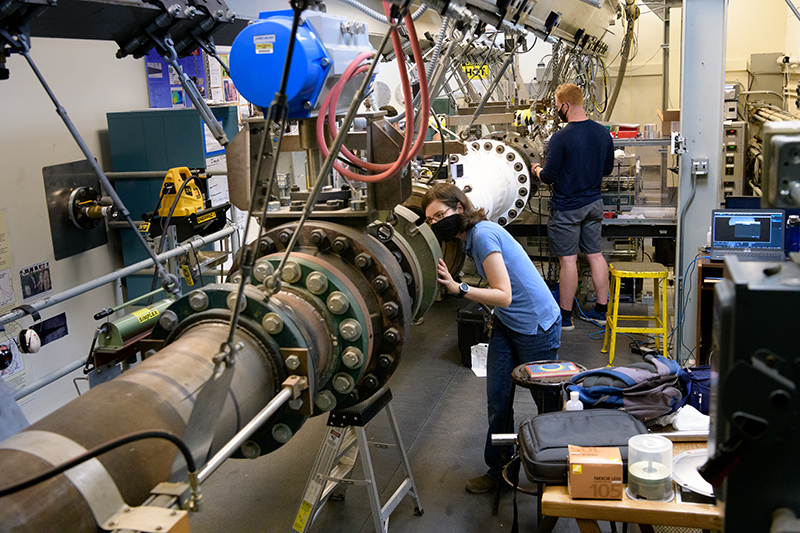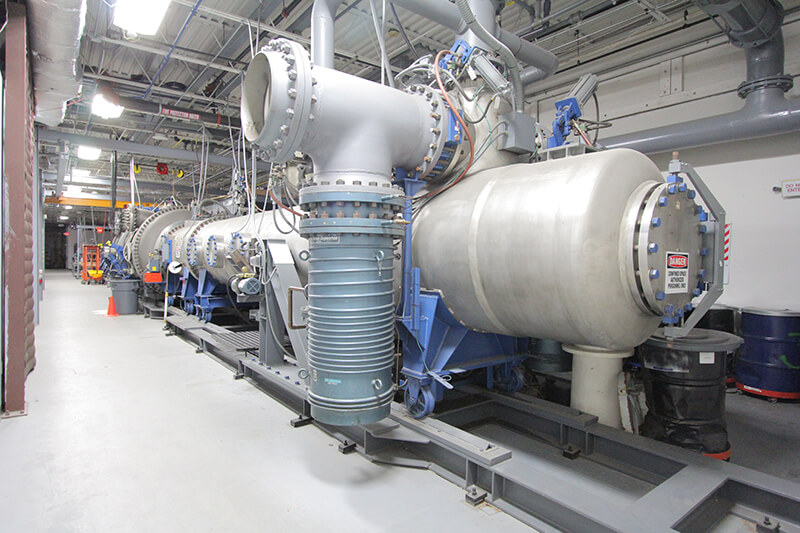July 27, 2021
New Purdue research building will offer a world’s first in hypersonic testing, materials development

Students work during the summer with Purdue’s Mach 6 quiet wind tunnel. A more advanced Mach 8 quiet wind tunnel will be part of the new hypersonics research building to be constructed at Purdue. (Purdue University/John Underwood)
Planned facility to house the only Mach 8 quiet wind tunnel in the world
WEST LAFAYETTE, Ind. — Imagine an aircraft flying 2,800 miles across the United States in only 15 minutes. A state-of the-art building ready for construction at Purdue University will provide the facilities to explore that idea through advanced hypersonic research.
The planned 65,000-square-foot Hypersonics and Applied Research Facility (HARF) will house two cutting-edge wind tunnels, enhancing Purdue’s world-leading capabilities in hypersonics evaluation and testing. The $41 million facility will house the only Mach 8 quiet wind tunnel in the world as well as a hypersonic pulse (HYPULSE) shock tunnel. The tunnels recreate different scenarios such as spacecraft re-entry or missile flight through the atmosphere as well as replicating unique engine conditions for extremely high-speed propulsion.
“Purdue’s rich hypersonics program includes both a broad bench of more than 40 experts and unique capabilities that allow the university to play an important role in the security of our nation,” said Theresa Mayer, Purdue’s executive vice president for research and partnerships. “This first-of-its-kind facility will further Purdue’s capacity to conduct research including tests and evaluations under real-world conditions for faculty, industry partners, federal agencies and other stakeholders.”
The Mach 8 quiet wind tunnel and the HYPULSE tunnel offer controlled environments to research several facets of high-speed flight. The new Mach 8 quiet wind tunnel more closely simulates flight and provides more accurate data than conventional hypersonic wind tunnels.
The HYPULSE tunnel uses a shock wave of high-temperature air to recreate specific hypersonic flight conditions. It will allow flight simulations at speeds ranging from Mach 5 to as high as Mach 40. Purdue will be only the second university in the U.S. to offer HYPULSE test capabilities. The university currently offers one of only two working Mach 6 quiet tunnels in the country.
 Purdue University’s recently added Hypersonic Pulse (HYPULSE) shock tunnel will be part of the planned hypersonics building for later this year. The tunnel was donated by Northrop Grumman Corp. (Northrop Grumman photo)
Download image
Purdue University’s recently added Hypersonic Pulse (HYPULSE) shock tunnel will be part of the planned hypersonics building for later this year. The tunnel was donated by Northrop Grumman Corp. (Northrop Grumman photo)
Download image
Supporting a national defense strategy
National pursuit of hypersonics systems by government and industry has intensified during the last few years. Hypersonic vehicles can travel more than five times the speed of sound and fly in the upper reaches of the atmosphere, significantly challenging an adversary’s ability to detect, track, target and engage. These systems are a top Department of Defense priority to ensure U.S. battlefield dominance, as competitors continue to advance similar programs. Hypersonics-related research is included in the FY22 President’s budget request at $3.8 billion, up by 20% from a $3.2 billion request in FY21.
This potential increase in funding would build on previous investments by federal agencies and industry to help better integrate hypersonic systems with the U.S national security strategy. The new HYPULSE tunnel is a donation from Northrop Grumman Corp. In 2019, Purdue received a contract from the Air Force Research Laboratory to support the development of the first quiet Mach 8 tunnel in the world, the first facility of its kind capable of collecting data at speeds greater than Mach 6. Collecting data at higher Mach numbers is critical to extending the understanding of flow physics, especially heat transfer and flight control effectiveness, as Department of Defense programs continue working to fly faster and farther.
Purdue’s own recent investments in hypersonics help to position the university as a compelling partner for national defense projects from industry and government. Hypersonics is a critical topic under two of Purdue’s Next Moves, recently announced strategic initiatives that will advance the university’s competitive advantage. Hypersonics research is a key component of Purdue’s National Security and Technology initiative. The Purdue Applied Research Institute, the new nonprofit applied research arm of the university, will leverage the university’s unique hypersonics capabilities to deliver innovative defense solutions for industry and government partners.
“This investment by Purdue University demonstrates our commitment to advancing national security technology, one of the pillars of Purdue’s Next Moves,” said Mung Chiang, Purdue’s executive vice president for strategic initiatives and the John A. Edwardson Dean of the College of Engineering. “Building the world’s fastest quiet wind tunnel and innovating manufacturing represent two more steps in creating America’s hypersonic engineering epicenter here at Purdue Aerospace District.”
Construction on the hypersonic building is scheduled to begin in September. The building is located in Purdue’s Aerospace District, a university-affiliated aerospace business hub for public and private research collaborations on research and commerce. Tenants in the district already include Rolls-Royce, Saab Defense and Security and SEL Purdue (Schweitzer Engineering Labs).
Providing a critical investigative and research testbed
In addition to the HYPULSE and the quiet wind tunnel, the building also will feature advanced facilities that will enable the study of high-temperature materials applications. Hypersonic flight can create air friction above 1,000 degrees Celsius, requiring unique processes and materials to withstand such conditions. The research facility offers the chance to design and test these new materials. It also will create space for Purdue researchers to further capabilities to design, build and test hypersonic systems.
Scott Meyer, managing director of Purdue’s Maurice J. Zucrow Laboratories, said the facility would enable faculty to use advanced laser-based optical diagnostic measurement techniques as part of the quiet wind tunnel and HYPULSE testing. The diagnostic techniques are able to make quantitative measurements at a million times per second, slowing testing observations to take in specific details such as what the air flow field direction is and what chemical reactions are occurring.
“The diagnostic measurement techniques are almost going to make the Mach 8 quiet wind tunnel and HYPULSE like brand new tools to investigate the physics of what is happening in these conditions,” Meyer said. “Researchers will be applying the techniques at the same conditions that would occur on real systems in flight and enable measurements that have never been made before under these extreme testing conditions.”
A better understanding of when and how airflow over a surface changes from smooth to turbulent is essential in the successful design of expendable and reusable hypersonic vehicles.
About Purdue University
Purdue University is a top public research institution developing practical solutions to today’s toughest challenges. Ranked the No. 5 Most Innovative University in the United States by U.S. News & World Report, Purdue delivers world-changing research and out-of-this-world discovery. Committed to hands-on and online, real-world learning, Purdue offers a transformative education to all. Committed to affordability and accessibility, Purdue has frozen tuition and most fees at 2012-13 levels, enabling more students than ever to graduate debt-free. See how Purdue never stops in the persistent pursuit of the next giant leap at https://purdue.edu/.
Writer, Media contact: Brian Huchel, 765-494-2084, bhuchel@purdue.edu
Sources: Theresa Mayer
Mung Chiang
Scott Meyer
Journalists visiting campus: Journalists should follow Protect Purdue protocols and the following guidelines:
- Campus is open, but the number of people in spaces may be limited. We will be as accommodating as possible, but you may be asked to step out or report from another location.
- To enable access, particularly to campus buildings, we recommend you contact the Purdue News Service media contact listed on the release to let them know the nature of the visit and where you will be visiting. A News Service representative can facilitate safe access and may escort you on campus.
- Correctly wear face masks inside any campus building, and correctly wear face masks outdoors when social distancing of at least six feet is not possible.
Note to journalists: Photos of the HYPULSE system and existing Mach 6 quiet wind tunnel are available on Google Drive. Journalists visiting campus should follow visitor health guidelines.

